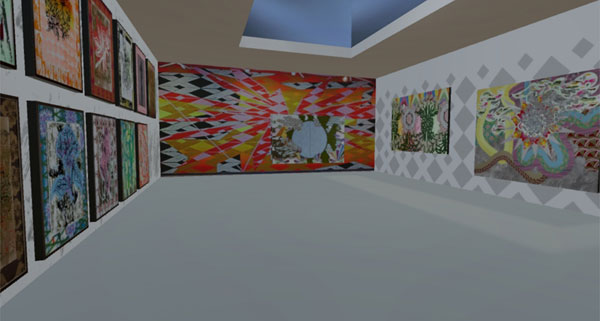by Kathrin Koebel, Doris Agotai, Stefan Arisona (FHNW) and Matthias Oberli (SIK-ISEA)
Virtual reality (VR) reconstruction offers a new interactive way to explore the archives of the Swiss Pavilion at the “Biennale di Venezia” Art Exhibition.
The Swiss pavilion at “Biennale di Venezia” offers a platform for national artists to exhibit their work. This well-known white cube showcases the changes in contemporary Swiss art from the early 50s to the present day. The aim of the “Biennale 4D” is to make the archives of the past bi-annual art exhibitions more comprehensible by creating an interactive explorative environment using innovative virtual reality (VR) technology. «Biennale 4D» poses multiple challenges including visualisation of historic content and its documentation, dealing with the heterogeneity and incompleteness of archives, interaction design and interaction mapping in VR space, integration of metadata as well as realising a virtual reality experience for the public space with current VR technology.
Design and development of the reconstructed exhibition environment
A pilot application was created by the Institute of 4D Technologies of the University of Applied Sciences and Arts Northwestern Switzerland FHNW and Swiss Institute for Art Research SIK-ISEA [1] to test the concept of the proposed VR experience. This functional prototype allows users to explore the pavilion and displayed art works of different epochs with the HTC Vive VR headset and hand controllers. It contains a 3D model of the pavilion based on the original design by Bruno Giacometti and a concept for visualisation of the exhibition content and its documentation. Exhibition samples (see Figure 1) of various documentation levels are included – for example, “thoroughly documented”, “fragmentarily documented” – as well as experimental art works, such as video installations. The current release of the prototype showcases exemplary portions of the selected exhibitions in the years 1952, 1984, 2007 and 2013. The development of a consistent visual language for the heterogeneous work posed a challenge. Numerous experiments were made to discover a suitable visualisation style (see Figure 2) that guides the user’s focus away from the building to the artworks and their documentation. These experiments included variables such as the degree of abstraction, deliberate lack of definition and level of chromaticity, and lessons from the field of archaeology have been applied for the handling of incomplete data.
Interaction with time, space and metadata
The prototype allows interaction with three dimensions which had to be reduced onto the two hand controllers available to the user. In this initial prototype one hand is assigned to time travel and the other hand is designated for spatial movement and interaction with the objects. The user is able to travel intuitively through time by means of interaction with the time machine object (see Figure 3). This three-dimensional item offers affordances to the user about the exhibition content of the years he’s passing by as he or she travels through time, navigating to the scene of the desired year. For spatial movement the application contains a navigation concept that allows the user to move within the virtual room either by position tracking of the user’s movement in the physical space or via teleportation. It provides basic haptic feedback in case of collisions. Other forms of spatial navigation were considered (e.g., a guided tour), however testing revealed a correlation between the user’s degree of freedom regarding movement and the perceived user experience. In addition, an information guide in the form of a virtual booklet offers metadata corresponding to the objects on display (see Figure 4). This supplementary information can be accessed by pointing with a laser ray towards the desired item. And, interactive hotspots have been added to the application to show additional material, such as archive photos.

Figure 1: Screenshot of the Biennale 4D prototype, showing the virtual reconstruction of the 2007 art exhibition in the “Malerei” hall of the Swiss pavilion.

Figure 2: Screenshot of the Biennale 4D prototype, displaying the chosen aesthetics for the visualisation of the historical content. The original design of the pavilion was reduced and blur has been added to the wall textures in order to intuitively guide the user’s focus to the documented art works.

Figure 3: Screenshot showing the time machine object which was created to allow the user to interact with the time dimension.

Figure 4: Screenshot of the information guide that allows interaction with the metadata of the art work.
Conclusion and future work
Biennale 4D poses a unique challenge as it combines a virtual art exhibition experience with archive functionalities through the use of virtual reality technology. This synthesis allows new approaches to exhibition reconstruction and the conclusive incorporation of historical material in this experimental virtual space. The curative work intertwines three layers of materials: histori-cal content (original artwork), its doc-umentation (archive photos and other artefacts) and the virtual room (mapping space). In particular the handling of the documentation layer leaves much room for interpretation and exploration. Furthermore, the nature of this application field requires thoughtful examination of aspects like substantiality, aesthetics as well as the concept of time.
Some other areas of focus for further work include further elaboration on the aesthetics of the visualisation including spatial design of the surrounds, improving the storytelling and developing a concept to present the application and allow its usage in the public space. Ongoing work will focus on offering access to the full content of the Biennale archives in an even more interactive and immersive way and letting a wider audience experience this valuable portion of Swiss art and cultural history.
Links:
www.biennale-venezia.ch
www.fhnw.ch/technik/i4ds
Reference:
[1] K. Koebel, O. Kaufmann, “Biennale 4D – Erschaffung einer Virtual Reality Experience zur Exploration der Archivbestände des Schweizer Pavillons an der Biennale Venezia”, https://kwz.me/hLd.
Please contact:
Kathrin Koebel
Fachhochschule Nordwestschweiz, Switzerland











